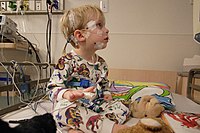
Photo from wikipedia
PurposeThere are no universally accepted guidelines for assessing driving readiness in adolescents with narcolepsy. The purpose of the present study was to survey pediatric sleep medicine providers regarding their current… Click to show full abstract
PurposeThere are no universally accepted guidelines for assessing driving readiness in adolescents with narcolepsy. The purpose of the present study was to survey pediatric sleep medicine providers regarding their current practice patterns for assessing driving readiness in adolescents with narcolepsy, knowledge of their state laws regarding physician reporting of unsafe drivers, and opinions regarding what physician duty ought to be.MethodsThis was an anonymous web-based survey distributed via the PedSleep listserv, which serves as a hub of communication for pediatric sleep medicine providers.ResultsA total of 52 pediatric sleep providers from 25 different states completed the survey. Eighty-eight percent of providers routinely assess driving readiness in adolescents with narcolepsy. Factors rated as “absolutely essential” by at least 50% of respondents included the following: history of previous fall-asleep crash or near miss, sleepiness (reported by patient), sleepiness (reported by caregiver), and cataplexy (reported by patient). Providers included maintenance of wakefulness testing: never (34%), if patient reports no/mild sleepiness (10%), if patient reports moderate/severe sleepiness (25%), or always regardless of patient symptoms (30%), and the median minimally acceptable result was 30 min (25–75th: 20–40 min). There was substantial lack of knowledge regarding legal obligations for reporting.ConclusionsThese results demonstrate great variability in practice patterns among pediatric sleep medicine providers for assessing driving readiness in adolescents with narcolepsy. In addition, it shows limited knowledge of the providers about their respective states’ laws. Further studies are required to identify the best approach to assess residual sleepiness in this population.
Journal Title: Sleep and Breathing
Year Published: 2019
Link to full text (if available)
Share on Social Media: Sign Up to like & get
recommendations!